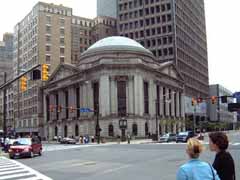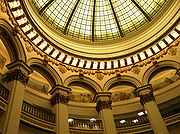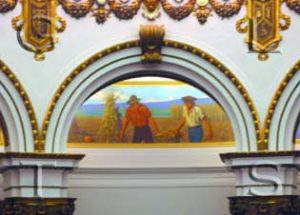

1908, Cleveland Trust Company Murals
Date: 1908
Dimensions: 13 Murals
Medium: Murals- oil on canvas
Owner/Location: Cleveland Trust Company, now owned by Key Bank Cleveland, Ohio
Description
Millet’s 13 murals, which circle the upper level of the rotunda, depict the rise of civilization in the Midwest. Starting sometime after the building was finished, he worked more than a year with three assistants to complete the paintings. About 18 months later, he died on the Titanic.

To see the murals in person, the bank building has now become a metro grocery store, “Heinen’s Downtown, Cleveland,” With the building situated on the corner you can enter the store either from 9th Street or Euclid and when you look up you will see the grand stained glass dome, supported by the beautiful arches and each of the 13 murals circling the, still grand space. If you want to get a closer look you have to exit the building and go next door on 9th Street, to the “Metropolitan at the 9” Hotel. There you can take the elevator to the third floor and follow the signs to the rotunda, and you will be able to walk around just under the murals up close.
You can see all the murals with additional commentary here:
http://www.glts.org/articles/cleveland_trust/
http://www.artographyonline.com/blog/2013/03/06/murals-of-francis-davis-millet/
 “Mural painting as a calling in itself was unheard of in this country until Millet organized the work at Chicago and brought together a remarkable group of artists,” stated the National Cyclopedia of American Biography. After the Chicago fair, where he also painted murals, Millet began to devote more time to that art form, and executed large works in several cities. While Millet is not considered one of the great masters of art, “his mural paintings are unquestionably among the greatest achievements in decorative art that this country has produced,” the National Cyclopedia stated.
“Mural painting as a calling in itself was unheard of in this country until Millet organized the work at Chicago and brought together a remarkable group of artists,” stated the National Cyclopedia of American Biography. After the Chicago fair, where he also painted murals, Millet began to devote more time to that art form, and executed large works in several cities. While Millet is not considered one of the great masters of art, “his mural paintings are unquestionably among the greatest achievements in decorative art that this country has produced,” the National Cyclopedia stated.

At the time Cleveland Trust was built, the goal was “building for a century to come,” St. Clair said. The granite building’s design, a reinterpretation of the Renaissance style, was intended to convey security, honesty and integrity, yet not be cold and austere. The rotunda is 85 feet high and 60 feet in diameter and is covered by a stained-glass dome in the Tiffany style. The stained-glass dome, the Millet murals and the iron and bronze railings all serve to “warm” the space.

Exhibitions / Provenance
Provenance:
Cleveland Trust now owned by Key Bank, Cleveland, Ohio
Literature
Research:
Publications:
http://www.glts.org/articles/cleveland_trust/
Millet and Cleveland had a loving relationship, in that a number of major buildings in the city are filled with some of his best and most mature mural painting.
Cleveland was the first Midwestern city to take architect Burnham’s ideas to heart. In 1895, inspired by the Columbian Exposition, the Cleveland Architectural Club sponsored a design competition for grouping Cleveland’s public buildings. While the contest did not produce results, it got the issue on the public agenda. Cleveland’s mayor got state legislation authorizing an expert commission to plan a civic center. One of the three men on the commission was Burnham – and in 1903 they presented a plan to arrange Cleveland’s public buildings around a grand mall with fountains and sculpture at either end. The federal building (which also contains Millet’s work) was finished in 1910, the county courthouse in 1912 and the city hall in 1916.

The Cleveland Trust building, completed in 1908, became yet another facet of this new vision for the nation, although it was a commercial building, not public. George Post was the architect; it’s not surprising that Millet, who had worked with him on the Columbian Exposition, was chosen to paint murals inside it. At the time, St. Clair explained, murals were a popular way to decorate the interior of buildings. It was all part of the vision that the arts should be expressed in grand civic structures.






